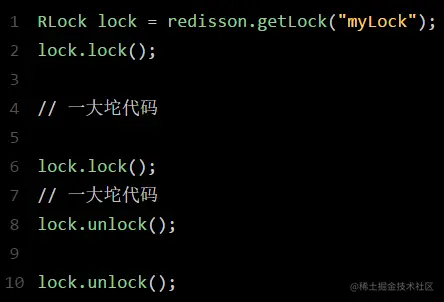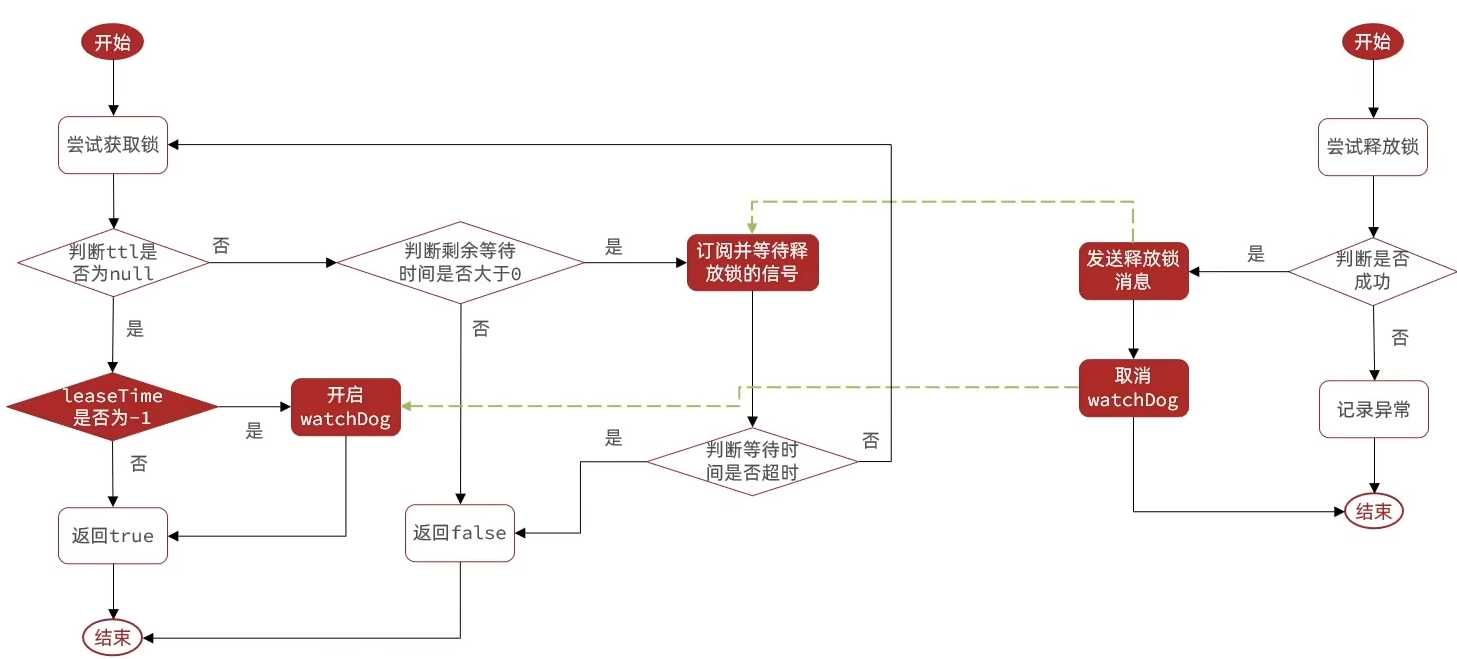目录
Redisson 加锁非常简单,还支持 redis 单实例、redis 哨兵、redis cluster、redis master-slave 等各种部署架构
RLock lock = redisson.getLock("cyk-test"); lock.lock(); lock.unlock();底层原理

加锁机制
废话不多说,直接看源码,下面的代码先不看,先看 tryAcquire 是如何获取锁的
private void lock(long leaseTime, TimeUnit unit, boolean interruptibly) throws InterruptedException { long threadId = Thread.currentThread().getId(); Long ttl = tryAcquire(-1, leaseTime, unit, threadId); // lock acquired if (ttl == null) { return; } CompletableFuture<RedissonLockEntry> future = subscribe(threadId); pubSub.timeout(future); RedissonLockEntry entry; if (interruptibly) { entry = commandExecutor.getInterrupted(future); } else { entry = commandExecutor.get(future); } ... }查看 tryAcquire 方法,点进去看发现调用了 tryAcquireAsync0 方法,这里 RFuture 继承自 java.util.concurrent.Future,表示这是一个异步的任务,get 方法会同步获取结果
private Long tryAcquire(long waitTime, long leaseTime, TimeUnit unit, long threadId) { return get(tryAcquireAsync0(waitTime, leaseTime, unit, threadId)); } private RFuture<Long> tryAcquireAsync0(long waitTime, long leaseTime, TimeUnit unit, long threadId) { return getServiceManager().execute(() -> tryAcquireAsync(waitTime, leaseTime, unit, threadId)); }查看 tryAcquireAsync 方法
private RFuture<Long> tryAcquireAsync(long waitTime, long leaseTime, TimeUnit unit, long threadId) { RFuture<Long> ttlRemainingFuture; if (leaseTime > 0) { ttlRemainingFuture = tryLockInnerAsync(waitTime, leaseTime, unit, threadId, RedisCommands.EVAL_LONG); } else { ttlRemainingFuture = tryLockInnerAsync(waitTime, internalLockLeaseTime, TimeUnit.MILLISECONDS, threadId, RedisCommands.EVAL_LONG); } ... }查看 tryLockInnerAsync 方法
<T> RFuture<T> tryLockInnerAsync(long waitTime, long leaseTime, TimeUnit unit, long threadId, RedisStrictCommand<T> command) { return commandExecutor.syncedEval(getRawName(), LongCodec.INSTANCE, command, "if ((redis.call('exists', KEYS[1]) == 0) " + "or (redis.call('hexists', KEYS[1], ARGV[2]) == 1)) then " + "redis.call('hincrby', KEYS[1], ARGV[2], 1); " + "redis.call('pexpire', KEYS[1], ARGV[1]); " + "return nil; " + "end; " + "return redis.call('pttl', KEYS[1]);", Collections.singletonList(getRawName()), unit.toMillis(leaseTime), getLockName(threadId)); }这是一段加锁的 lua 脚本,用于保证原子性,参数解释如下:
KEYS[1] 表示加锁的 key
ARGV[1] 表示锁 key 的默认超时时间
ARGV[2] 表示加锁的客户端 ID,由 UUID:线程 ID 组成
客户端在第一次加锁完成,会设置一个 key 为客户端 ID,value 为加锁次数的 hash 数据结构:

现在知道了内部方法的逻辑,往回倒一步,重点看我加在代码中的注释
private RFuture<Long> tryAcquireAsync(long waitTime, long leaseTime, TimeUnit unit, long threadId) { RFuture<Long> ttlRemainingFuture; if (leaseTime > 0) { ttlRemainingFuture = tryLockInnerAsync(waitTime, leaseTime, unit, threadId, RedisCommands.EVAL_LONG); } else { ttlRemainingFuture = tryLockInnerAsync(waitTime, internalLockLeaseTime, TimeUnit.MILLISECONDS, threadId, RedisCommands.EVAL_LONG); } // 这里是定义了加锁Lua脚本的异步任务,通过CompletableFuture编排 CompletionStage<Long> s = handleNoSync(threadId, ttlRemainingFuture); ttlRemainingFuture = new CompletableFutureWrapper<>(s); // 这个f依赖ttlRemainingFuture的结果,如果入参的leaseTime<=0会触发看门狗机制 // 否则按照设置的过期时间来过期 CompletionStage<Long> f = ttlRemainingFuture.thenApply(ttlRemaining -> { // lock acquired if (ttlRemaining == null) { if (leaseTime > 0) { internalLockLeaseTime = unit.toMillis(leaseTime); } else { scheduleExpirationRenewal(threadId); } } return ttlRemaining; }); // 返回编排好的CompletableFuture return new CompletableFutureWrapper<>(f); }把 RFuture 返回以后,就到了 get 方法阻塞获取方法这里
private Long tryAcquire(long waitTime, long leaseTime, TimeUnit unit, long threadId) { return get(tryAcquireAsync0(waitTime, leaseTime, unit, threadId)); } private RFuture<Long> tryAcquireAsync0(long waitTime, long leaseTime, TimeUnit unit, long threadId) { return getServiceManager().execute(() -> tryAcquireAsync(waitTime, leaseTime, unit, threadId)); }最后回到了这里
private void lock(long leaseTime, TimeUnit unit, boolean interruptibly) throws InterruptedException { long threadId = Thread.currentThread().getId(); Long ttl = tryAcquire(-1, leaseTime, unit, threadId); // lock acquired if (ttl == null) { return; } // 这里的 subscribe 就是 Redis 订阅解锁的 lua 脚本中的 publish CompletableFuture<RedissonLockEntry> future = subscribe(threadId); pubSub.timeout(future); RedissonLockEntry entry; if (interruptibly) { entry = commandExecutor.getInterrupted(future); } else { entry = commandExecutor.get(future); } ... }接着看下面循环获取锁的逻辑
try { while (true) { // 自旋尝试获取锁 ttl = tryAcquire(-1, leaseTime, unit, threadId); // 看Lua脚本,ttl为null说明锁获取到了 if (ttl == null) { break; } // waiting for message if (ttl >= 0) { try { // 注意这里的tryAcquire和之前的tryAcquire不是同一个东西,这里是信号量的tryAcquire // entry.getLatch()这里返回的是信号量,释放锁的代码会释放一个许可 // 如果没有可用的许可,会一直休眠直到超时时间 ttl ms entry.getLatch().tryAcquire(ttl, TimeUnit.MILLISECONDS); } catch (InterruptedException e) { if (interruptibly) { throw e; } entry.getLatch().tryAcquire(ttl, TimeUnit.MILLISECONDS); } } else { // 当 key 存在但没有设置剩余生存时间时,pttl返回 -1,会走到这个逻辑 // 我感觉正常流程走不到这个逻辑,因为当前线程无非是看到锁存在或者不存在 // 看到锁不存在等于加锁成功了,因为Lua脚本是原子性的 // 看到锁存在,默认也给了超时时间 // 这里就没有设置超时时间,一直等释放锁的许可 if (interruptibly) { entry.getLatch().acquire(); } else { entry.getLatch().acquireUninterruptibly(); } } } } finally { unsubscribe(entry, threadId); }这里设计的巧妙之处就在于利用了消息订阅、信号量的机制,它不是无休止的盲等机制,也避免了不断的重试,而是检测到锁被释放才去尝试重新获取,这对 CPU 十分的友好
锁互斥机制
此时如果客户端 2 来尝试加锁,同样走进 RedissonLock#lock 方法,会咋样呢?第一个 if 判断会执行 exists myLock,发现 myLock 这个锁 key 已经存在了。接着第二个 if 判断,判断一下,myLock 锁 key 的 hash 数据结构中,对应客户端 2 的 ID 的 key 的 value 为 1,也没有。最终会获取到 pttl myLock 返回的锁 key 的剩余生存时间,进入 while 循环,不停的尝试加锁
可重入锁机制
那如果客户端1都已经持有了这把锁了,结果可重入的加锁会怎么样呢?

此时会执行可重入加锁的逻辑,走第二个 if 逻辑,对客户端 1 的加锁次数累加 1,此时 myLock 数据结构变为下面这样:

总结

